
Titan was a family of United States expendable rockets used between 1959 and 2005. The Titan I and Titan II were part of the US Air Force's intercontinental ballistic missile fleet until 1987. The space launch vehicle versions contributed the majority of the 368 Titan launches, including all the Project Gemini crewed flights of the mid-1960s. Titan vehicles were also used to lift US military payloads as well as civilian agency reconnaissance satellites and to send interplanetary scientific probes throughout the Solar System.
AMSAT is a name for amateur radio satellite organizations worldwide, but in particular the Radio Amateur Satellite Corporation (AMSAT) with headquarters at Washington, D.C. AMSAT organizations design, build, arrange launches for, and then operate (command) satellites carrying amateur radio payloads, including the OSCAR series of satellites. Other informally affiliated national organizations exist, such as AMSAT Germany (AMSAT-DL) and AMSAT Japan (JAMSAT).
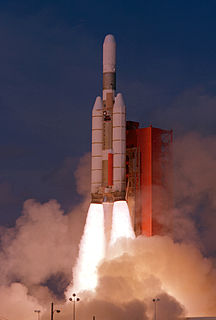
The Titan IIIC was an expendable launch system used by the United States Air Force from 1965 until 1982. It was the first Titan booster to feature large solid rocket motors and was planned to be used as a launcher for the Dyna-Soar, though the spaceplane was cancelled before it could fly. The majority of the launcher's payloads were DoD satellites, for military communications and early warning, though one flight (ATS-6) was performed by NASA. The Titan IIIC was launched exclusively from Cape Canaveral while its sibling, the Titan IIID, was launched only from Vandenberg AFB.
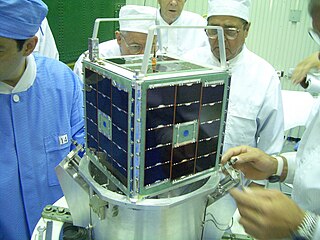
AMSAT-OSCAR 51 or AO-51 is the in-orbit name designation of a now defunct LEO amateur radio satellite of the OSCAR series; formerly known as ECHO, built by AMSAT. It was launched on June 29, 2004 from Baikonur Cosmodrome, Kazakhstan on a Dnepr launch vehicle. It is in sun synchronous low Earth orbit.
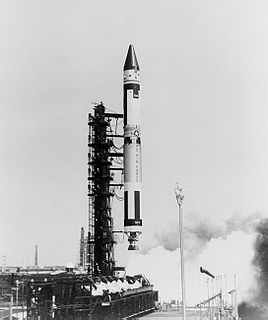
The Titan IIIA or Titan 3A was an American expendable launch system, launched four times in 1964 and 1965, to test the Transtage upper stage which was intended for use on the larger Titan IIIC. The Transtage was mounted atop two core stages derived from the Titan II. The Titan IIIA was also used as the core of the Titan IIIC.
Orbiting Vehicle or OV, originally designated SATAR, comprised five disparate series of standardized American satellites operated by the US Air Force, launched between 1965 and 1971. Forty seven satellites were built, of which forty three were launched and thirty seven reached orbit. With the exception of the OV3 series and OV4-3, they were launched as secondary payloads, using excess space on other missions.

OPS 0855, also designated OV4-3, was an American boilerplate Manned Orbiting Laboratory spacecraft launched in 1966. It was flown to demonstrate the launch configuration for future MOL missions. A number of research payloads, designated Manifold, were carried on board, which were intended to operate for 75 days. However, the spacecraft ceased operations after just 30. It was built from a decommissioned HGM-25A Titan I first stage oxidizer tank, bolted to a Transtage. It was part of the MOL and Orbiting Vehicle projects.

The 6555th Aerospace Test Group is an inactive United States Air Force unit. It was last assigned to the Eastern Space and Missile Center and stationed at Patrick Air Force Base, Florida. It was inactivated on 1 October 1990.
An amateur radio satellite is an artificial satellite built and used by amateur radio operators. It forms part of the Amateur-satellite service. These satellites use amateur radio frequency allocations to facilitate communication between amateur radio stations.
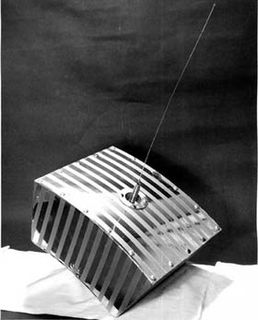
OSCAR II is the second amateur radio satellite launched by Project OSCAR into Low Earth orbit. OSCAR II was launched June 2, 1962, by a Thor-DM21 Agena B launcher from Vandenberg Air Force Base, Lompoc, California. The satellite, a rectangular box weighing 10 kg (22 lb), was launched as a secondary payload (ballast) for Corona 43, the fifth launch of a KH-4 satellite.
OSCAR III is the third amateur radio satellite launched by Project OSCAR into Low Earth Orbit. OSCAR 3 was launched March 9, 1965 by a Thor-DM21 Agena D launcher from Vandenberg Air Force Base, Lompoc, California. The satellite, weighing 16.3 kg, was launched piggyback with seven United States Air Force satellites. The satellite employed no attitude control system. OSCAR III linear transponder lasted 18 days. More than 1000 amateurs in 22 countries communicated through the linear transponder. The two beacon transmitters continued operating for several months.

LituanicaSAT-1 was one of the first two Lithuanian satellites. It was launched along with the second Cygnus spacecraft and 28 Flock-1 CubeSats aboard an Antares 120 carrier rocket flying from Pad 0B at the Mid-Atlantic Regional Spaceport on Wallops Island to the International Space Station. The launch was scheduled to occur in December 2013, but later was rescheduled to 9 January 2014 and occurred then. The satellite was broadcasting greetings of Lithuanian president, Mrs. Dalia Grybauskaitė. The satellite was deployed from the International Space Station via the NanoRacks CubeSat Deployer on February 28, 2014. All LituanicaSAT-1 subsystems have been turned on, tested and proved to be working properly. The mission is considered a complete success by its team of engineers. The mission ended upon the reentry and disintegration of the satellite on July 28, 2014.
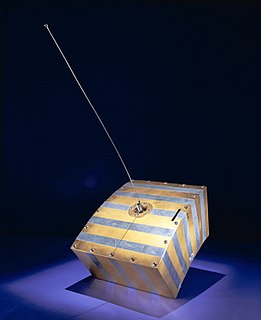
OSCAR I is the first amateur radio satellite launched by Project OSCAR into low Earth orbit. OSCAR I was launched December 12, 1961, by a Thor-DM21 Agena B launcher from Vandenberg Air Force Base, Lompoc, California. The satellite, a rectangular box weighing 10 kg., was launched as a secondary payload (ballast) for Corona 9029, also known as Discoverer 36, the eighth and final launch of a KH-3 satellite.

Orbiting Vehicle 2-1, the first satellite of the second series of the United States Air Force's Orbiting Vehicle program, was an American life science research satellite. Its purpose was to determine the extent of the threat posed to astronauts by the Van Allen radiation belts. Launched 15 October 1965, the mission resulted in failure when the upper stage of OV2-1's Titan IIIC booster broke up.
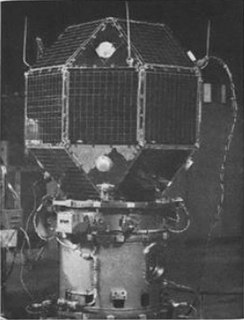
Lincoln Experimental Satellite 1, also known as LES-1, was a communications satellite, the first of nine in the Lincoln Experimental Satellite program. Launched by the United States Air Force (USAF) on February 11, 1965, it pioneered many then-advanced technologies including active use of the military's SHF band to service hundreds of users. LES-1 did not have a successful operational life due to being placed in a suboptimal orbit, but the satellite briefly became significant in its post-operational life when, after more than 40 years of inactivity, it spontaneously resumed transmissions in 2012.
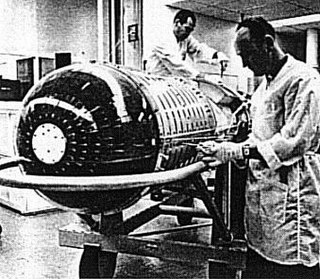
Orbiting Vehicle 1-1, was the first satellite in the OV1 series of the United States Air Force's Orbiting Vehicle program. OV1-1 was an American Earth science research satellite designed to measure radiation, micrometeoroid density, and magnetic fields in orbit. Launched 21 January 1965, the mission resulted in failure when, after a successful launch of its Atlas booster, OV1-1's onboard Altair motor failed to fire.

Orbiting Vehicle 1-2, launched 5 October 1965, was the third, and first successful, satellite in the OV1 series of the United States Air Force's Orbiting Vehicle program. A radiation measuring satellite designed to conduct research for the planned Manned Orbital Laboratory project, OV1-2 was the first American spacecraft to be placed into orbit on a western trajectory. The satellite stopped functioning in April 1967 after a series of technical problems starting two months after launch.

Orbiting Vehicle 2-3, the second satellite of the second series of the United States Air Force's Orbiting Vehicle program, was an American solar astronomy. geomagnetic and particle science research satellite. Launched 22 December 1965 along with three other satellites, the mission resulted in failure when the spacecraft failed to separate from the upper stage of its Titan IIIC.
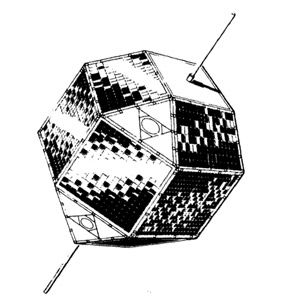
Lincoln Experimental Satellite 3, also known as LES-3, was a communications satellite, the third of nine in the Lincoln Experimental Satellite. Launched by the United States Air Force (USAF) on 21 Dec 1965, it was stranded in a Geostationary Transfer Orbit rather than its planned circular high orbit. Despite this, LES-3 returned good data on communications propagation in the UHF band.
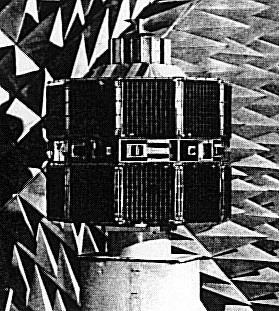
Lincoln Experimental Satellite 4, also known as LES-4, was a communications satellite, the fourth of nine in the Lincoln Experimental Satellite, and the first of the series designed for operations at geosynchronous altitudes. Launched by the United States Air Force (USAF) on 21 December 1965, it demonstrated many then-advanced technologies including active use of the military's SHF band to service hundreds of users.


















